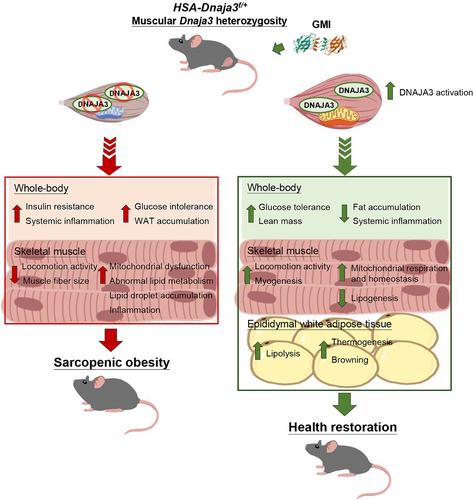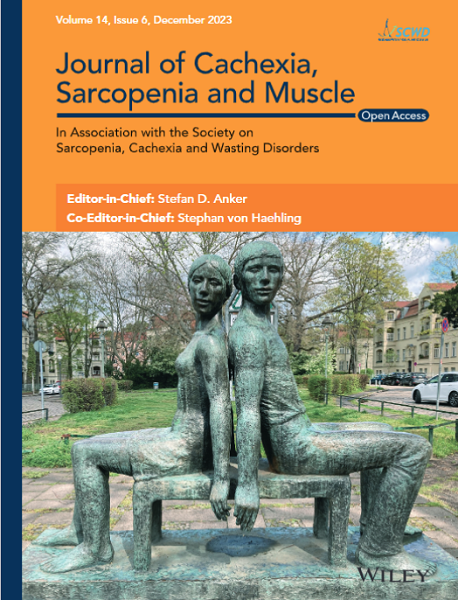Sarcopenic obesity is characterized by excess fat mass and diminished muscular mass/function. DNAJA3, a mitochondrial co-chaperone protein, plays a crucial role in skeletal muscle development. GMI, an immunomodulatory protein, promotes myogenic differentiation through DNAJA3 activation. This study aims to elucidate the physiological effects of muscular Dnaja3 haploinsufficiency on mitochondrial dysfunction and dysregulated lipid metabolism and to assess the efficacy of GMI in rescuing sarcopenic obesity both in vitro and in vivo.
We generated mouse strain with Dnaja3 heterozygosity (HSA-Dnaja3f/+) specifically in skeletal muscle. The body weight, body composition, and locomotor activity of WT and HSA-Dnaja3f/+ mice were examined. The isolated skeletal muscles and primary myoblasts from the WT and HSA-Dnaja3f/+ mice, at young or old age, were utilized to study the molecular mechanisms, mitochondrial respiration and ROS level, mitochondrial proteomes, and serological analyses, respectively. To evaluate the therapeutic efficacy of GMI, both short-term and long-term GMI treatment were administrated intraperitoneally to the HSA-Dnaja3f/+ young (4 weeks old) or adult (3 months old) mice for a duration of either 1 or 6 months, respectively.
Muscular Dnaja3 heterozygosity resulted in impaired locomotor activity (P < 0.05), reduced muscular cross-sectional area (P < 0.0001), and up-regulation of lipogenesis (ACC2) and pro-inflammation (STAT3) in skeletal muscles (P < 0.05). Primary myoblasts from the HSA-Dnaja3f/+ mice displayed impaired mitochondrial respiration (P < 0.01) and imbalanced mitochondrial ROS levels. A systemic proteomic analysis of the purified mitochondria from the primary myoblasts was conducted to show the abnormalities in mitochondrial function and fatty acid metabolism (P < 0.0001). At age of 13 to 14 months, the HSA-Dnaja3f/+ mice displayed increased body fat mass (P < 0.001), reduced fat-free mass (P < 0.01), and impaired glucose and insulin tolerance (P < 0.01). The short-term GMI treatment improved locomotor activity (P < 0.01) and down-regulated the protein levels of STAT3 (P < 0.05), ACC2, and mitochondrial respiratory complex III (UQCRC2) (P < 0.01) via DNAJA3 activation. The long-term GMI treatment ameliorated fat mass accumulation, glucose intolerance, and systemic inflammation (AST) (P < 0.05) in skeletal muscle, while enhancing thermogenesis (UCP1) (P < 0.01) in eWAT. GMI treatment promoted myogenesis, enhanced oxygen consumption, and ameliorated STAT3 (P < 0.01) through DNAJA3 activation (P < 0.05) in vitro.
Muscular Dnaja3 haploinsufficiency dysregulates mitochondrial function and lipid metabolism then leads to sarcopenic obesity. GMI emerges as a therapeutic regimen for sarcopenic obesity treatment through DNAJA3 activation.



